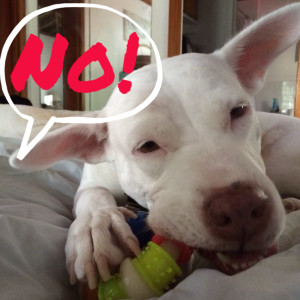Why I’ve Never Taught My Deaf Dog the Sign for “No”!
How do you teach your deaf dog the sign for, “no”?
This is a pretty common question, however I don’t actually have a sign for “no”!
First, the problem with “no” is that it is really unclear. No what? No when? No where? While you might believe that your meaning is easily understood, your dog may be quite confused. Do you mean, “no, not now” or “no, never,” or “no not like that,” or “no, not here”? There is no way to be sure exactly which behavior you want to stop or change when you just use the sign “no”.
Second, when you use the sign for “no” you are actually interacting with the dog. This is problematic as you might even be inadvertently giving attention to the behavior that you would like to reduce or not see repeated.
Third, when using “no,” you might be delivering it in a frustrated, exacerbated, or angry/forceful manner. If that interaction is unpleasant the dog may decide to avoid you in the future. He might find this communication frightening and therefore associate you with scary things. The dog also might feel agitated at your emotional “no!” delivery and this could be met with aggression.
The dog may just decide to give up and figure that as they aren’t getting it “right” anyhow, they might as well not even try. These four side effects (escape/avoidance, fear, aggression, apathy) are possible when we introduce something with the intention to stop or decrease behavior and none of them are potential secondary scenarios that we want as an end result.
Finally, the fourth reason is that “no” doesn’t teach what we want the dog TO do. That is, instead of spending the time working on no, which runs the risk of all of the previous issues, why not use your energies to teach your dog what you do want them to do. Instead of jump, teach sit. Instead of race out of the door, teach impulse control. Instead of stealing off of counters, teach settle in a spot. Teaching an incompatible or alternative behavior that you can cue in place of some behavior that you don’t like helps with communication. Too, bonus, the training that you do builds trust with your dog. This creates a win/win situation for all!
Going forward you want to try to set everyone up for success by avoiding situations which may produce unwanted behaviors. In addition to this management strategy, work on teaching behaviors that you do want to see more of. While training behaviors that you want repeated, you can communicate in a clear fashion and reinforce those behaviors so that you make them worth while to do over and over.
These methods will make your pup’s and your life less stressful and more fun, which is a great way to enjoy each other’s company!

